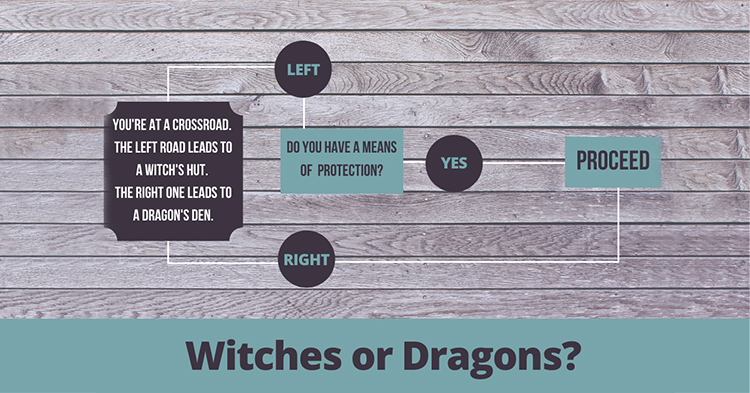What You Need to Know About Interactive Storytelling
In 1979, the Choose Your Own Adventure gamebooks came to be, bringing with them a new and innovative approach to storytelling. Giving readers free rein to choose how the story goes has inspired a lot of books, games, and even movies since then. In fact, they’re accredited with their part in helping role-playing games such as Dungeons and Dragons. In a way, they also led to the evolution of interactive storytelling, even back then.

This method of storytelling has had a very dramatic impact on many things in our lives. It facilitated not just role-playing games, but other things like choosing how a story you’re reading goes and even how a movie ends. This idea of giving the observer options has far surpassed the idea of alternative endings and bonus materials on DVDs.
What is Interactive Storytelling?
Interactive storytelling is showcasing a story with an undetermined ending. Unlike normal stories, this method of storytelling offers the audience alternative endings depending on their choices. This, in turn, makes them active participants rather than just passive observers or recipients of the story.
However, in this day and age, there are different interpretations of the term ‘interactive storytelling’. While the most commonly understood meaning refers to the CYOA phenomenon with books, games, and media, there’s another interpretation: stories that have interactive elements. This brand of storytelling is mostly found with interactive ebooks. Additionally, it’s been spreading as a marketing technique. It is sometimes referred to as visual storytelling, with services like Shorthand helping bring them about.
This blog post will focus on the former, but you can still check out some of our other posts on interactive ebooks and how to create interactive textbooks.
Interactive Movies
When it comes to interactive movies, the first one that comes to mind is usually Netflix’s Black Mirror: Bandersnatch. Being one of the first movies to adopt such a storytelling tactic, it made waves in the industry. The movie revolves around helping the protagonist make choices throughout the film until you get to the ending.
Movie games are a bit hard to pin down in terms of category, but they can be similar to that of Bandersnatch. Take for example Death Come True. This game is set up as a live-action Japanese movie. Instead of it playing out on its own, your decisions guide the protagonist’s actions, but it plays like a science fiction mystery movie.
With the movie’s positive reception, Netflix branched out the interactive storytelling technique with its comedy show Unbreakable Kimmy Schmidt. It’s clear Netflix’s success on both fronts will help it keep employing this technique in the future. Not only that, but it has inspired others in the industry to give it a go. In fact, even Fox is said to be giving it a go.
Interactive Games
One of the first role-playing games that comes to mind when thinking of interactive storytelling is The SIMs. Not because it was the first of its kind, but because of how far wide it spread and adapted throughout the years. You, as a player, get to create the entire world from scratch and customize it to your liking. It’s not merely a world, though, it’s a family, interactions with other players and forming well-developed lives.
That has since evolved with games like Final Fantasy, World of Warcraft, and even PUPG. There is a whole list of more of them you can check out. The point is, role-playing games keep evolving and of their own accord happen to be a part of the trend.
However, there are other mobile games that have come into the picture over the past few years and increased in popularity. Games like Choices and Chapters are a combination of both stories and games, with a bigger emphasis on the stories. Many writers have switched to apps like these because of how far they’ve gone. The books follow specific stories, but each choice made can improve or hinder your chances with particular leads. As most of these apps are for romantic stories, you play the role of the protagonist on the lookout for a partner.
For more story games, you can click on this link or this link here.
Interactive Stories
There are many kinds of interactive stories serving various different purposes. Even documentaries haven’t been immune to this tactic. That’s where the Seven Deadly Digital Sins, a web documentary, comes in. The web story is dedicated to addressing the seven deadly sins of the digital age and how they translate with our web use as well as the harmful side effects. The website allows you to navigate through the different sins, to discover the stories and confessions associated with them. There’s background music, videos, and a lot of interactivity.
One of the other unique experiences is the collaboration project between Pierre Hermé and Nicolas Buffe. This story is proof of marketing done right, as, if you’re familiar, Pierre Hermé is actually a French pastry chef, while Nicolas Buffe is a French artist based in Tokyo. The book is very immersive, with telescopes you can zoom in and out of in order to discover hidden secrets. Races you can click on the spacebar to win. It’s not a mere static story, you get to play a part in it.
Another impressive take is The Boat by Nam Lee that was adapted by Matt Hyunh. The adaptation became an experience onto itself not only by illustrating the whole thing but with the many additional elements that bring the story to life. From sound effects in the background that suit each scene to words moving and floating about, as well as images moving in the direction of the waves. It gives you the feeling that you’re not just reading a book, you’re living it.
As is apparent, the interpretations of this technique differ from one author to another, and from one book to another. In fact, transforming your own story into an interactive one has gotten easier with apps such as Galatea, if you don’t want to do the work yourself.
How Do You Create an Interactive Story?
Compared to the usual methods of storytelling, this one is a bit more complex. Not only do storytellers have to work out an entire story timeline, but they also have to come up with multiple timelines based on just one choice change. The more options you give the user, the more elaborate the branches of the story go.
However, the trick is to keep it contained. You can either limit the options or create scenarios where more than one choice can still lead to the same conclusion. Think of flow charts and how they go. Then expand or limit the options so that the story is more manageable and doesn’t go out of hand. In the end, it still needs to be a cohesive story and the main purpose is the reader’s enjoyment, not confusion.

There are a number of apps that can help you create interactive stories, we’ve brought you some today.
Twine
An open-source app you can download on both Mac, Windows, and even Linux. It will help you plan and structure your interactive story in the form of web pages. While the tool doesn’t require development skills, it can go much farther with them. Though it bears mentioning that it takes some getting used to.
Celestory
Celestory helps you play games, get immersed in diverse worlds, and then create your own. This app might be a little complex and has three pricing options. The Basic Plan is free, the Pro Plan is from €3600 to €4900 a year (depending on whether there’s a sale), and the Business Plan requires personal customization. There are of course other options, but the fact that it has its own academy lets you know that this app is not messing around.
Inklewriting
Inklewriting, unlike most of the options on this list, eases the writing process with the branches your story is heading in and gives it a cleaner look. It’s a free tool designed to allow anyone to write and publish interactive stories.
Episode
This is a mobile storytelling network and platform. Episode has recreated some of Hollywood’s blockbusters in a version where you can live the lives of the characters. But not just that, you can use the app to create your own stories.
Storystylus
Storystylus is another publishing platform that makes it easy to create narrative-driven games. The downside is that it might require a little coding. While the beta version is currently free, there might be special pricing for other packages.
Conclusion
Interactive storytelling may have been around for years, but it’s only these past couple of decades that we’ve seen increased advancements in the technology around them and their uses. From movies to games and even normal stories, this storytelling technique has changed the way we as observers receive the content and are no longer passive.
It is safe to say that jumping onto that particular bandwagon can help scriptwriters, authors, and game creators expand their work and abilities.
Read more here.
Why Interactive Ebooks Are Your Best Teaching Resource
The Science Behind Storytelling in Sales
How to Brand Your Business with the Art of Storytelling
















Stephanie
July 7, 2023Is there a reason the article didn’t include choicescript (the software)?